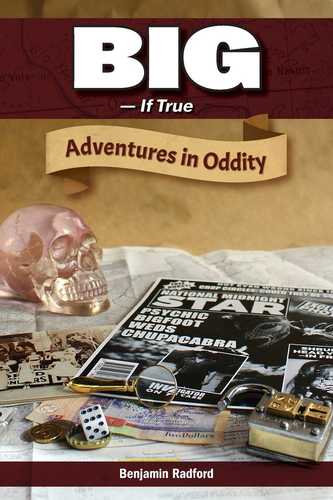Big – If True

Big – If True
Author: Benjamin Radford
This collection of Skeptical Inquirer magazine columns by investigator and folklorist Benjamin Radford guides readers on a science-based (yet open-minded) examination of 70 fascinating and mysterious topics. Drawing on two decades of first-hand research, Big-If True separates fact from fiction using forensics, science, psychology, folklore, and more. Radford examines these and dozens more mysteries including Bigfoot, reincarnation, chupacabras, Icelandic elves, conspiracy theories, UFOs, miracles, the terrifying Goat-Man, crop circles, subliminal advertising, sea serpents, wandering trees, medical mysteries, and hypnotist thieves—plus a 1990 Elvis sighting. For mystery lovers and armchair investigators alike, this book offers a look behind the scenes at investigating oddities and curiosities, both ancient and modern.
Praise for Big If True

Chapters
A Skeptic’s Guide to Ethical and Effective Curse Removal • Egging the Equator • Did Elves Delay Road Construction in Iceland? • Mysteries of the Coral Castle • Is Elvis Presley in Home Alone? • Searching to Noah Vale • The Bell Witch Mystery • The Myth of the Walking Tree • Bailing in the Mummies • Might Fright Cause White? • Have You Seen the Toucan Man? • Bark at the Moon
Chapter 2: Monsters
Cyptozoology and Global Warming • The Mystery of the Texas Chupacabra • Texas Goat-Men and the Chupacabra • A Wakey Water ‘Monster’ • Globsters Ahoy! • Investigating Mothman’s Red Eyeshine
Chapter 3: Ghosts
Do Einstein’s Laws Endorse Ghosts? • ‘M’ is for Mysterious Marks • Have I Ever Seen a Ghost? • Soul Scales • The Cockington Church Ghost Photo • Can Electromagnetic Fields Create Ghosts? • Infrared Cameras and Ghost Hunting • A Closer Look at Orbs • The Sweet Spirit Sounds of Rosemary Brown • Playing with Past Lives: The Virginia Boy and the Dead Marine • Playing to an Empty Room: Ghost Hunting and ‘Singapore Theory’
Chapter 4: Mysterious Powers and Places
A Time to Die? • Crop Circle Origins • The GIGO Problem: Crop Circle Research Edition • Channeling Ancient African Wisdom—Or Not • Mystery of the Paulding Light • Dowsing: Dubious and Discredited • Fatima Miracle Claims All Wet • Uri Geller Revisited • Did Psychic Visions Locate Missing California Boy? • Beware Mesmer Thieves! • Secrets of Spectacularly Skewered Skin
Chapter 5: UFOs
The Phantom Menace of UFO Revelation • The Mysterious Phoenix Lights • The Mysterious, Invisible ‘Rods’
Chapter 6: Health and Medicine
Bodytalk: Boon or Bogus? • Exercising the Brain Gym • Kinoki Foot Pads • Diving HeadOn Into Pseudoscience • Subliminal Advertising, Trumpian and Otherwise • Freaky Feldenkrais • Measuring Near-Death Experience • A 100C Grain of Truth to Homeopathy? • Battle Over the BMI • The Mysterious Morgellons Malady • Childbirth—Natural or ‘Unnatural’? • Vegetable Oil or Snake Oil?: The Pseudoscience of “Oil Pulling” • The Pseudoscience of Personalysis Left Brain or Right Brain? • Sweating the Small Stuff • The Science of Chemistry and Non-Science of eHarmony • DaVinci’s ROM: Range Of Motion or Rip Off Machine?
Chapter 7: Conspiracies
Sandy Hook School Shooting: The Adam Lanza Death Certificate Conspiracy • Curious Contrails: Death From the Sky? • The Truth About the 9/11 Truthers • Is America a Sheeple Factory?
Chapter 8: Skepticism
Legitimizing Woo • Just Asking Questions • Caught Between the Possible and the Paranormal • Dealing With Believers in Skeptical Investigation • Anomaly Hunting • Mystery Solved—According to Whom? • Paranormal Qualifications
Sneak Peek
Introduction
Big—If True is a collection of seventy Skeptical Inquiree columns that appeared in Skeptical Inquirer magazine over the years, through 2020. I joined a daunting cast of columnists in the world’s flagship skeptical magazine, among them James “The Amazing” Randi, Massimo Polidoro, Massimo Pigliucci, Joe Nickell, Martin Gardner, Robert Sheaffer, Stuart Vyse, Harriet Hall, and others.
Each had their own specialties, and I knew that if I was going to be in such esteemed company I’d have to find my niche. I began the column in part to foster more interaction with the skeptical community and the public, and thought it would be fun to take questions: let readers decide what they’d like to see examined in the magazine’s pages.
I had my own interests and investigations, of course, from ghosts to urban legends, lake monsters to psychics. I was busy enough doing my own work—plus editorial duties for the magazine and a newsletter—that I certainly wasn’t short of mysteries to investigate. However I enjoyed the challenge of tackling questions and curiosities readers had, which may or may not be on our writers’ radars. I pitched the idea to Skeptical Inquirer’s indefatigable editor Ken Frazier, who was game but asked me to keep the columns short (or at least shorter than most of the others) for space reasons.
I’ve done hundreds of investigations over the years: journalistic investigations, folkloric research, paranormal investigations, and so on. Though topics have varied greatly the common theme is that my goal is to solve the mystery and understand what’s going on. If I’m going to devote time and effort into looking into a subject, I want to take it seriously and investigate to the best of my ability (within financial and other practical constraints).
These topics—if real—are important. If psychic powers exist, that would be incredibly important to know and for science to understand (not to mention put to practical use finding missing persons and preventing pandemics, for example). If ghosts are real, that’s a fascinating and important avenue for physicists to pursue. If Bigfoot exist, that too is of legitimate interest to biologists, zoologists, and others; we’d need to understand what these animals are, where they fit into the tree of life, and how thousands of them have somehow managed to exist into the modern day leaving no physical traces of their presence. All these topics, and dozens more in this book, are in a phrase Big—If True.
As I noted in my book Scientific Paranormal Investigation: How to Solve Unexplained Mysteries, investigation can be seen as an exercise in finding the asterisk amid the headline claims. Paranormal claims are like eye-catching, full-color advertisements touting some spectacular bargain. Of course, hidden near and among the most sensational and exciting claims, there is almost always an asterisk. The function of the asterisk is to direct readers to the caveats, the parts of the Big Exciting Claim that make it not quite so true, in very tiny print at the bottom of the hiding the devil in the details. Paranormal claims invariably follow the same pattern: The big headline, the marquee claim is made: Bigfoot Body Found! Unexplained UFO Lights Seen Over New Jersey! Psychic Helps Solve Crime! That’s all most people read or see, but, like advertisements, they are only part of the truth.
Investigators look for the asterisk, the specific details about the claims. It is the fine print, the asterisk information, the specific details that will prove or disprove the claims; that is where the truth lies, and that is where investigation begins. Paranormal and unusual claims, whether true or not, cannot be taken at face value; they must be carefully and methodically researched.
In preparing this book I have left most of the columns as they were first published. Most of the topics are evergreen, and I omitted a few topics that were no longer relevant (such as a piece about a bogus health product that’s thankfully no longer available). I expanded on a few columns that spurred later, more in-depth investigations. In a few cases where the nature of the query was especially timely I updated the piece to reflect the status as of 2020, but I resisted the urge to revisit topics unless there were glaring anachronisms.
Because these were originally published as magazine columns and had to conform to a word limit, I was as comprehensive as I could be within the constraints of the format. I could not—and was not trying to—write a comprehensive treatment of these topics, and instead focused narrowly on the specific question posed to me. For those seeking more information I include references in each chapter.
This collection reflects a cross section of skeptical investigation-related queries from across the spectrum including die-hard skeptics, dyed-in-the-wool believers, journalists, Skeptical Inquirer readers, and curious laypeople. It serves as a (hopefully) informative and entertaining sampling of strange and unexplained topics, approached with an eye toward solving the mysteries and exploring what’s really behind the curtain (or under the mask revealed by meddling kids).
Some of these topics have been the subject of episodes of my podcast Squaring the Strange, which this year celebrated its third anniversary. Podcasts are often transient and subject to vagaries beyond any single person’s control, so it may or may not be active when you read this. If it is, please check out our show and subscribe if you’re so inclined; if it isn’t, there will be an archive of old shows, most of which are just as contemporary as these questions.
This book is partly a memoir, partly a catalogue of investigations, and partly a companion (or antidote) to the myriad mystery books I devoured as a teenager and young adult. These books had sensational titles such as Strange But True!, Mysteries of the Unexplained, Searching the Unknown, and the like. This is the sort of book I wish I’d found at the time, a kind of skepticism-tackles-the weird collection that didn’t really exist in the 1970s and 1980s. With that, let’s dive into the world of claims that are… Big—If True.